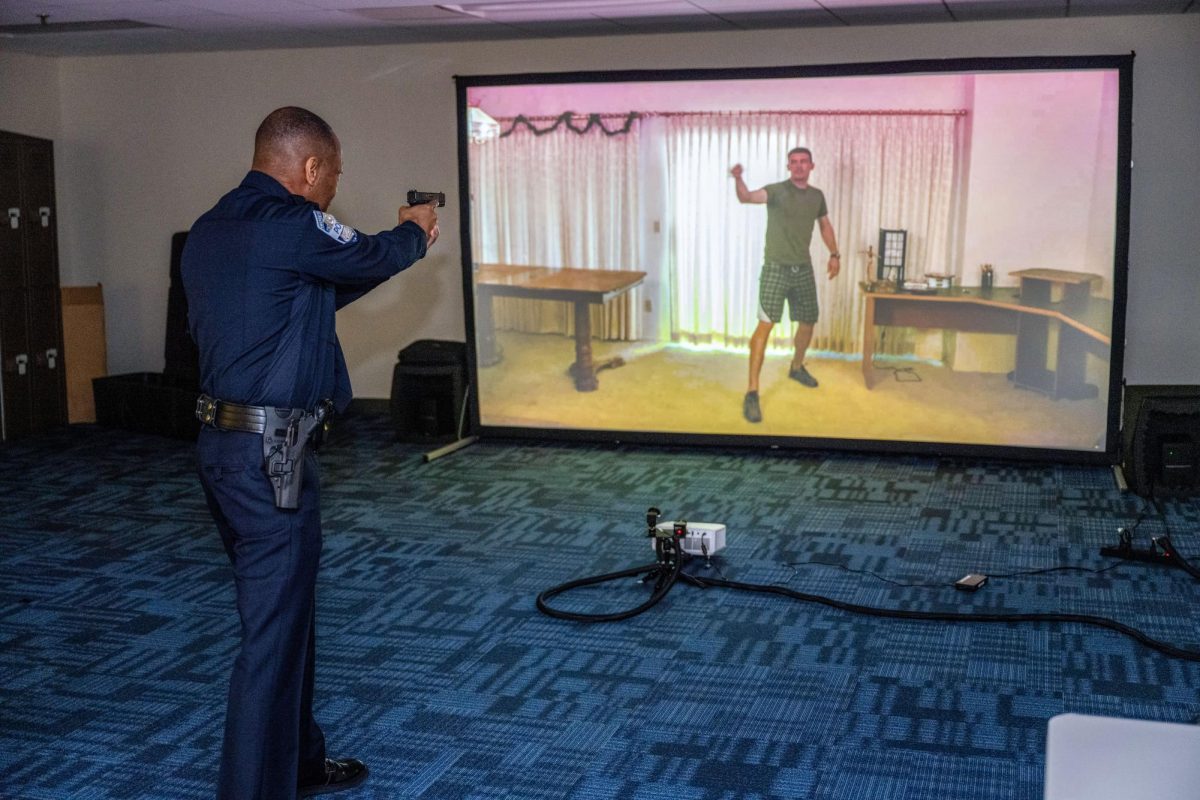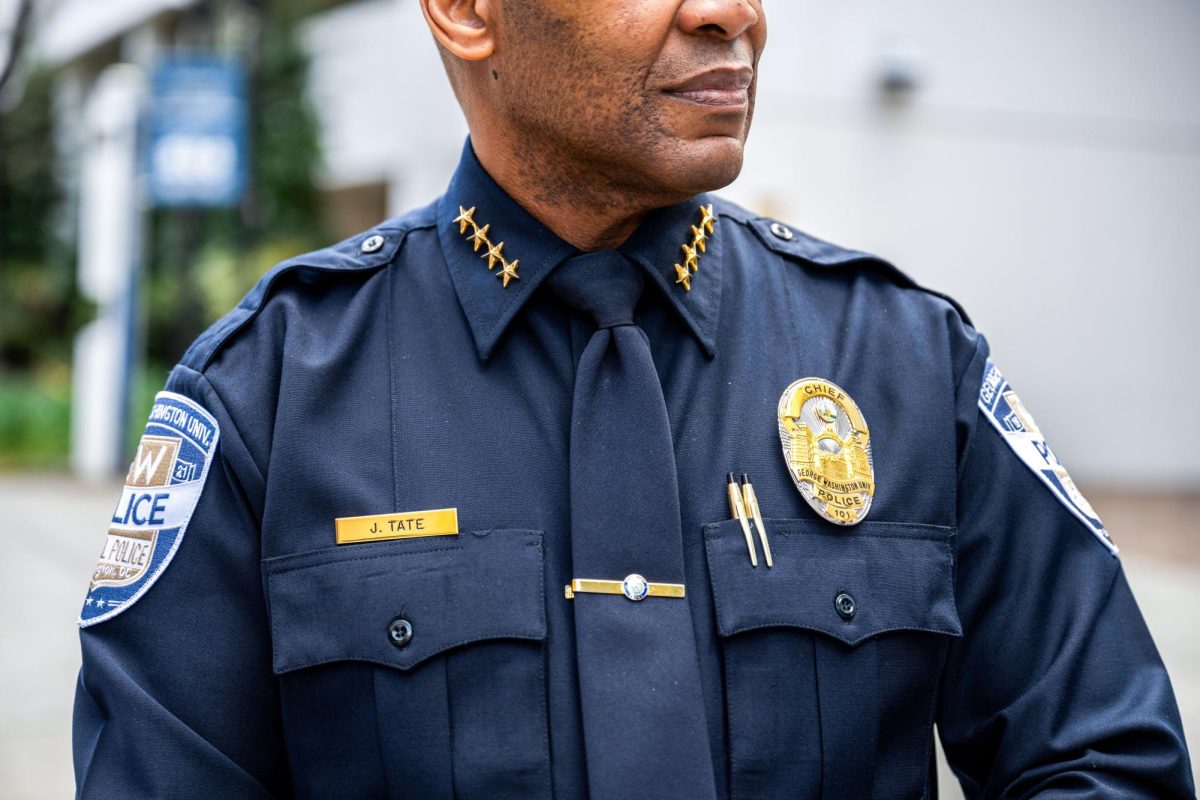GW Police Department Chief James Tate aimed a Glock 17 at the projection of a man waving a knife.
Tate stood with one foot forward, arms grasping the firearm as he spoke sternly to the simulation cast on the wall before him.
“Put the knife down,” Tate barked. “Drop the knife. That’s all I need you to do, is drop the knife.”
The man in the pre-recorded video yelled back, “There’s no talking!”
But Tate continued to talk, insisting the man drop the knife until the suspect finally obeyed.
In a dark room in the labyrinthine basement of Rome Hall, which houses GWPD’s campus headquarters, Tate practiced shooting a Glock 17 with a modified laser barrel in front of GW’s virtual training simulator — an approximately $50,000 piece of equipment made by military and police training company VirTra.

Captain Ian Greenlee, one of two officers who run the simulator, said the Glock 17 was modified to feel and weigh about the same as the firearms seven officers currently carry on campus as part of a plan launched by the Board of Trustees nearly a year ago to arm 22 officers with 9 mm handguns. The first phase of the program — which consisted of the arming of Tate and Captain Gabe Mullinax — concluded in September and the second phase began with the arming of five additional officers in February.
GWPD firearm training includes two hours of monthly training with the simulator, a requirement the department announced last May.
In a walk-through with The Hatchet last week, Tate first calibrated the simulator by firing the training gun at animated targets on the screen, then shot a warm-up round, knocking down eight black, human-shaped silhouettes against the backdrop of a 3-D animated field. He then demonstrated the mock scenarios that GWPD officers undergo to train before receiving their firearms.
In the final scenario, a man in a hoodie entered a nondescript shop and approached the counter. After speaking briefly with the clerk, the man shot the clerk before firing at Tate.
“Drop the gun, drop it, drop it now,” Tate shouted. Tate pulled his handgun from the holster but did not return fire. He said it may be “a little bit tough for students” to watch officers fire a weapon, even in a training scenario.
“The purpose was to show in that moment, if we had to discharge, I would have discharged,” Tate said. “We talked it over with comms. What we really didn’t want to do was go through where you’re actually seeing me or the officer firing a weapon and discharging it at a bad actor.”
Officials stated in September that the University would complete the second phase of arming — equipping four additional officers with handguns, on top of Tate and Mullinax — by the end of that month. But Tate said he paused between the first and second phases of the plan because the police department “didn’t want to rush things,” especially as students began regular campus demonstrations in the fall in reaction to the Israel-Hamas war.
“We didn’t want to rush,” Tate said. “If you remember, last semester, we had a lot of activity on campus, First Amendment activity that we were focused on.”
The Faculty Senate also passed a resolution in October calling on officials to pause the second phase of arming until officials released the full community feedback on the decision to arm officers, along with any changes to liability insurance and GWPD operational costs. Tate said the resolution “certainly wasn’t a factor” for him in pausing implementation.
“No need to rush, we want to get it right,” Tate said.

Tate said phase two of the program will end in the coming days or weeks. Officials selected members of the Campus Safety Advisory Committee, a group announced alongside the arming announcement consisting of students, faculty, staff and neighborhood residents, on Friday.
Tate said he believes implementation is “going well.” GWPD will post an additional “minor revision” to its use of force policy based on suggestions from faculty in about a week, Tate said.
Students protested the arming decision in the weeks following the arming announcement last spring, and hundreds of faculty signed a letter in May calling for the decision’s reversal. Student Government Association President Arielle Geismar announced last week the launch of the GWPD Accountability Working Group, which plans to advocate to reverse the arming of GWPD supervisors.
Tate said he was aware of the group and is open to collaborating with them.
“We still understand that people are still uncomfortable, to some degree, with where we are,” Tate said. “I get that. We’re sensitive to that.”
Tate said he has not received any complaints regarding armed officers’ presence at student demonstrations on campus this year.
“What we would typically want to do is try to hang back, as much as we can, beyond the periphery,” Tate said. “I tend not to go to those because I know people are going to look to say, ‘the chief is there.’”
While Tate has been absent from most student demonstrations, he observed a February pro-Palestinian demonstration in University Yard, and Mullinax has been present for at least two demonstrations.
GWPD released its annual statistical review for 2023, which showed that the number of calls that community members made to request GWPD’s services dropped from 8,178 in 2022 to 7,130 in 2023. The review also stated that the department received six complaints last year, compared to two in 2020 and one each in 2021 and 2022.
Tate said the announcement to arm officers spurred an increase in complaints.
“The good thing is we’re in the single digits, in terms of overall numbers, and that’s what we want,” Tate said. “We want to keep those numbers low.”
Tate said he plans to fill three remaining vacant department supervisor roles in the coming weeks, bringing the planned total number of armed supervisors to 22. GWPD posted an opening for captain of operations — Mullinax’s current position — on Friday.
Tate said he is still working to recruit for vacant officer positions.
“We’re working every day to recruit the best-qualified individuals for these jobs,” Tate said. “Recruiting is much harder today than it used to be.”
Tate said beyond filling vacancies, he does not have plans to expand GWPD’s staff, but that there may be room to increase staff in the future because the type of calls officers respond to has changed since the pandemic. Tate said he hopes to communicate with commuter students on self-defense and safety while traveling through campus at “odd hours” during the rest of this semester and next fall.
“I didn’t realize we have such a huge commuter student population for GW, I hadn’t thought of that,” Tate said. “But they are on our campus, they’re walking through all hours of the day, so they also need to understand how best to keep themselves safe.”
Tate finished his meeting with The Hatchet by distributing “challenge coins,” which the chief hands out to groups he works with. One side of the coin displays GW’s seal and the other depicts the GWPD chief badge, emblazoned with the words “Trust,” “Transparency” and “Accountability.”





